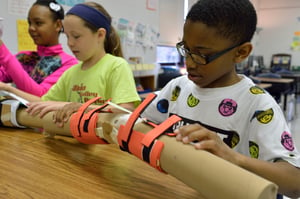 Within STEM, adults and children are often confused about the differences between science and engineering, especially with regard to how the two connect in elementary school. Both subjects require students to manipulate and test materials, engage in arguments based on evidence and work in teams, but there are crucial differences between the two fields. Before, during and after children engage in an engineering design challenge, it’s important to help them understand what makes each field distinct. These four questions can help you frame your explanation of the differences between engineering and science.
Within STEM, adults and children are often confused about the differences between science and engineering, especially with regard to how the two connect in elementary school. Both subjects require students to manipulate and test materials, engage in arguments based on evidence and work in teams, but there are crucial differences between the two fields. Before, during and after children engage in an engineering design challenge, it’s important to help them understand what makes each field distinct. These four questions can help you frame your explanation of the differences between engineering and science.
What’s the simple definition?
Science is the body of knowledge that explores the physical and natural world. Engineering is the application of knowledge in order to design, build and maintain a product or a process that solves a problem and fulfills a need (i.e. a technology).
What’s the procedure?
Scientists use the scientific method. Engineers use the engineering design process. The scientist starts with asking a question. Then they do background research, formulate a hypothesis, test that hypothesis by conducting an experiment, analyze the data and communicate their results. Engineers start by defining the problem, then they identify the criteria and constraints, brainstorm ideas, plan, create a technology and improve upon their design.
What’s the goal?
 Scientists and engineers have different goals. Scientists seek to describe and understand the natural world. Engineers consider various criteria and constraints in order to design solutions to problems, needs and wants that better the lives of humans, animals and/or the environment.
Scientists and engineers have different goals. Scientists seek to describe and understand the natural world. Engineers consider various criteria and constraints in order to design solutions to problems, needs and wants that better the lives of humans, animals and/or the environment.
What’s the result and impact?
Scientists use their varied approaches—controlled experiments or longitudinal observational studies—to generate knowledge. The final result might be a research paper or a book, and the knowledge therein can be used to help us understand and make predictions about the natural world. Engineers use scientific knowledge to create a technology. What does this mean in a real-world context? Use this example: a virologist is a scientist who researches how viruses are spread and how they affect the human body. A biomedical engineer can use the virologist's research to create an anti-viral drug that blocks a certain virus from spreading to new cells in the body.
In this way, both engineers and scientists are extremely important, and both fields benefit from the ingenuity and hard work of its counterpart. In some cases, scientists rely on the innovations that engineers design to further their research (e.g. microscopes or monitors), for example. To help students envision the wide range of STEM careers and opportunities available to them, it’s important to reinforce distinctions between the fields and deepen their understanding and appreciation.The four aforementioned questions can help as you address the E in STEM. We’ve also created a video to share with students to support their learning. Check it out below.








